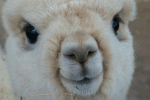Articles by Alpaca World Magazine:
THE ART OF HAND-CRAFTING ALPACA DUVETS
Magdalena Kit
THE ART OF HAND-CRAFTING ALPACA DUVETS
Magdalena Kot
and
Malgorzata Radziak
We created the ?my alpaca? brand and range of products because we believe that healthy, comfortable and luxurious sleep is essential to a long life and sustained happiness. To make the very best bedding possible, we decided to combine modern textile knowledge and materials with traditional hand-quilting methods and artisanal attention to detail. Thus, our work preserves and promotes the quality and artistry of meticulous craftsmanship ? and makes it available to today?s discerning customer.
It all started with a small alpaca farm near Krosno at the Sub Carpathian region of Poland. In the course of our work we have got to know and love alpacas - gentle, happy animals, generously giving of their fibre, which happens to be a medium suited to hand labour and a perfect material for duvets and pillows that are as beneficial as they are luxurious. A duvet filled with alpaca fibre has unique thermoregulatory characteristics; it adapts to your body temperature during sleep, does not retain moisture and is hypoallergenic. In addition to being healthy and natural, alpaca fibre is also extraordinarily soft and lightweight. Truly the best nature can offer. And we decided to make the best alpaca duvets by hand, for unmatched comfort and quality in every detail.
TAILOR?s GUILD TRADITION
I remember my grandmother having hand-quilted duvets in casings of blue and pink silk satin damask. They felt heavy and luxurious. Changing the bed linens was always a moment I waited for to admire the flowery damask patterns. It?s hard to find this quality nowadays.
The tradition of hand-quilting duvets goes back hundreds years. It is rooted in the Guild of Tailors established in 1272 in Krakow. Together with corsetry and embroidery, hand-stitching of bed linens, pillows and duvets developed into a profession requiring a lot of mastery and patience. The first duvets were filled with sheeps wool, later on with feathers and down. In XIX and XX century hand-crafting duvets became popular at convents, where nuns with patience would stitch duvets for hours, providing extra income to their communities. Duvets, pillows and bed linens were among the most precious components of a noble bride?s dowry.
As of the 1960?s machine stitched duvets became widely available and hand-quilting as a profession was slowly forgotten. Many duvet workshops closed down. Nuns who used to make duvets passed away without leaving followers. There are only a few craft masters left in Poland and, sadly, no more exams for new masters are organized by the guild. It is obvious that due to the painstakingly long production time, six to seven hours for hand-stitching a small duvet and up to 25 hours for a king size one, hand made duvets cannot beat the volume and efficiency of machine-quilted bedding made in under 10 minutes and effectively compete in the marketplace.
SAVING AN OLD PROFESSION FROM BEING FORGOTTEN
In recent years however, we are observing a very encouraging global trend: craftsmanship is in more demand than ever and small manufacturers are experiencing an overwhelming renaissance. Again, people are increasingly looking for products that last and have their own history and soul. It inspired us to join the movement, because we believe that craftsmanship is an expression of quality, passion, and requires a particular mindset.
At My Alpaca, we handcraft each duvet and pillow with attention to every detail, using traditional guild quilting methods. Our carding machine is a renovated classic that has served generations of master craftsmen ? and we acquired it and restored it with the knowledge and experience of artisan quilters working today. Our looms are built according to the traditional designs. We developed our proprietary stitching patterns together with master-craftsmen who also helped us to select and train a new generation of quilters. We are very proud to be protecting an endangered handicraft from disappearing while making such luxurious and beneficial products, entirely by hand.
HOW TO MAKE A PERFECT ALPACA DUVET?
Our process is exacting and demanding, but it is the only way to ensure perfection.
[Image alpaca fibre in hand / sheering]
The story of every duvet begins with the washing of newly shorn raw alpaca fibre. We use 100% alpaca fibre sourced from European farms. We wash it using only mild, un-fragranced detergent with no chemical additives, allowing our products to be recommended by the Polish Society of Allergology.
[image carding machine]
The most important stage of fibre processing is called carding. During this phase, hundreds of tiny needles on the machine?s rollers comb the fibre into strands of fine, ordered threads. After two complete rounds of carding, the fibres are arranged into a perfectly soft layer several centimetres thick.
[image LAYERS]
Next, the prepared fibre filling is placed between two layers of the chosen natural textile casing, which has been pre-cut to correspond to the duvet size and our proprietary superb-fit shape.
[image PATTERNS]
With the layers of casing and filling arranged in perfect order, we draw the no-slip quilting pattern on top to guide the needle during the next step.
[image QUILTING]
Our special hand-quilting method is the most laborious stage of the production process and it is what guarantees the long-lasting no-slip performance of our duvets. We combine the layers in a way that keeps the fibre from shifting, thus preventing the empty areas and resulting cold spots that are characteristic of machine quilting. This way we can achieve maximum thermoregulation with minimum duvet weight.
[image BINDING]
We finish all our duvets with high-quality natural cotton binding in white or featuring our signature print.
A single mid-size duvet takes 15 hours to complete.
ALPACA ENVELOPED IN NATURAL FABRICS
We enclose supple layers of pure alpaca fibre in an all-natural casing made with densely woven dye-free cotton or a smooth snow-white blend of cotton and silky bamboo.
PRODUCT INNOVATION AND MODERN DESIGN
The story of My Alpaca is not only one of traditional technologies but also one of modern design.
If you look closely, you will notice that the corners extend out beyond a regular rectangle. This is one of the keys to our products? performance. Thanks to this proprietary shape, our duvets and pillows fill out their covers more snugly than regular bedding, leaving no empty corners. Some people even report that our special corners make it easier to put on the duvet cover.
Our hand-quilting pattern differs from machine quilting, allowing even distribution of heat and preventing cold spots from appearing at the seams.
Our trademarked binding, designed especially for My Alpaca by artist Małgorzata Lasocka, features our signature print in elegant indigo cotton.
My Alpaca has been recognised by the design circles in Poland. Among others, our products received in 2015 the Łódź Design Festival?s MUST HAVE award, which is given each year to the 65 best new products on the market.
BESPOKE OFFER
Because it is so easy to introduce modifications to the hand-production process, and because we are eager to deliver on customer needs, our offer is uniquely flexible. We are able to produce limited product series that reflect client requirements in terms of sizeing (which differs greatly by market), fibre fill level (all season, winter and summer), casing fabric, binding colour and label contents.
We are proud to produce hand-crafted items that meet the highest standards. Our products are created with heart and are much more than a sum of their parts, giving our customers a healthy, comfortable sleep.
If you wish to know more visit us at www.myalpaca.eu/en
Tweet


